It’s always a good idea to accumulate a bit of experience caring for your dragon before you start complicating his habitat.
But once you’ve managed to keep your lizard healthy and happy for about a few months or so, there’s nothing wrong with adding some decoration to your pet’s home.
You can do so in a variety of ways.
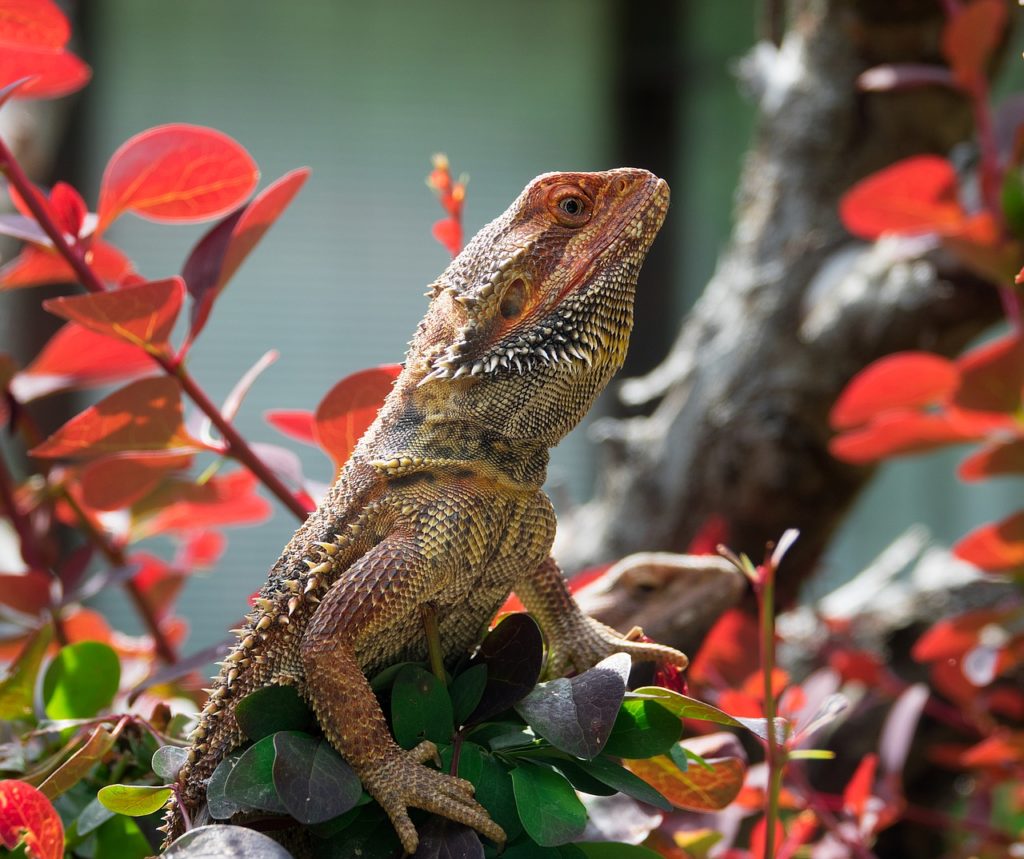
You could, for example, attach realistic photos to the back wall of the habitat, or you could install some faux rockwork.
You could also add some realistic-looking food and water dishes, or experiment with different substrates.
But many bearded dragon keepers wonder if they can add plants to their pet’s enclosure.
We’ll explore this issue below, point out some of the things you’ll want to consider before doing so, and share a few pointers that may help you in your terrarium-decorating endeavors.
Quick Navigation
Can You Keep Live Plants in a Bearded Dragon Tank?
In short: Yes, you can install live plants in your bearded dragon’s enclosure.
However, there are a number of things you’ll need to think about before heading to the local nursery to stock up on greenery.
For example, you’ll want to answer the following questions for yourself:
- Do you have any experience caring for houseplants or are you starting from scratch?
- Do you have the extra time, energy and desire to not only care for your pet, but some live plants too?
- Are you willing to accept the small, but non-zero possibility that the plants will harm your pet?
Every time you increase the complexity of your lizard’s habitat, you increase the chances of something going wrong.
This is why most breeders – whose success is directly tied to their ability to keep their dragons healthy – maintain very simple, utilitarian habitats.
However, there is a very important flip side to this coin: Increasing the complexity of your pet’s habitat by adding things like climbing branches, cage furniture and plants will likely improve your pet’s quality of life.
Plants may also allow you to enjoy your pet and his habitat more, which may help encourage you to spend more time caring for your pet.
So, as a keeper, you need to weigh these competing forces and decide how important plants are to you and how much risk you are comfortable accepting on behalf of your pet.
If, after considering these issues, you feel like plants are a good idea for your pet’s enclosure, you can begin trying to select the best plants for your pet’s enclosure.
9 Safe Bearded Dragon Plants
The following nine plants are among the safest species to use in bearded dragon enclosures, and they’re often well-suited to terrarium life.
1. Haworthia Plants (Haworthia spp.)
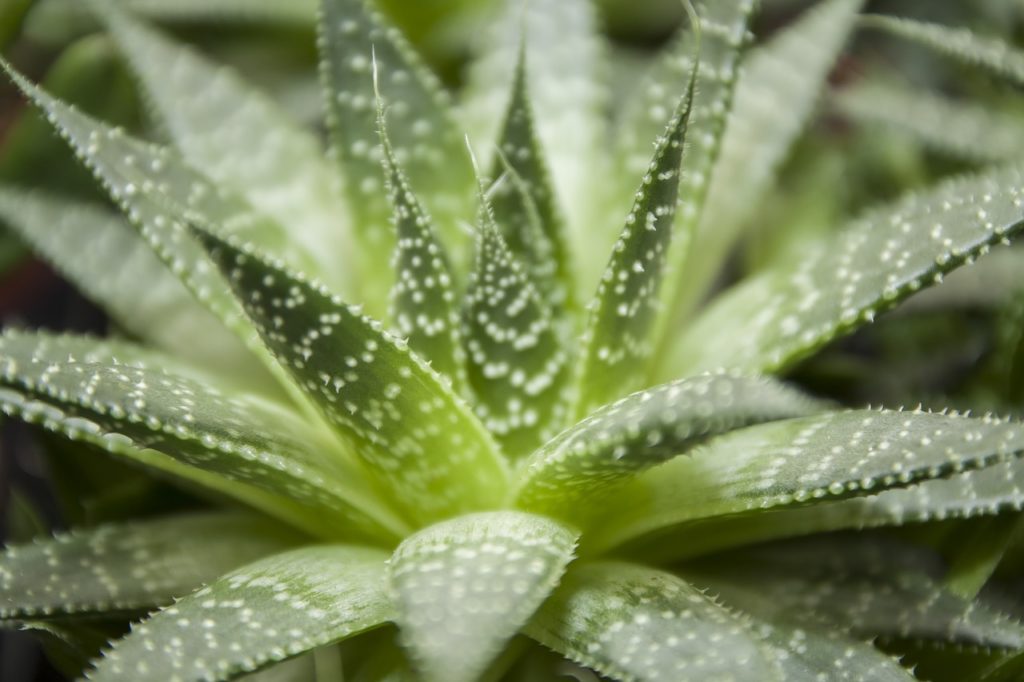
Hailing from arid regions of South Africa, haworthia plants are some of the most popular terrarium plants for those who keep desert-dwelling species.
There are dozens of species in this genus, but Haworthia cooperi and Haworthia reinwardtii are two of the most widely available and well-suited for your bearded dragon enclosure.
Nevertheless, most species in this genus are hardy, easy to maintain and thought to be completely harmless to bearded dragons.
One of the things that make haworthia plants so well-suited for bearded dragon habitats is their small size.
They typically grow as a small rosette of leaves and most only measure a few inches in diameter. Some species also have brightly colored leaf tips or other types of interesting markings.
2. Echeveria (Echeveria spp.)

Like haworthia plants, echeveria plants are native to arid regions, but these plants are native to the Americas.
This is a large genus of plants, with many sources citing more than 150 named species.
Additionally, botanists have created several cultivars and hybrids, giving you even more choices.
Echeveria plants are thought to be harmless to bearded dragons, and they often thrive when planted in terrariums.
- HAND SELECTED: Growing echeveria seeds is a hassle — our live plants are FULLY ROOTED IN 2 INCH...
- EASY SUCCULENT PLANTS: These live plants are nearly as simple to care for as artificial succulents....
- ZEN WALL DECOR: Display potted succulents in bohemian macrame hangers, on a modern plant stand or...
Some of the species in the genus are noteworthy for being able to thrive in dimmer conditions than some other succulents.
Many echeveria plants grow as rosettes or globe-shaped plants, and several species have attractive colors.
3. Prickly Pear Cacti (Opuntia spp.)
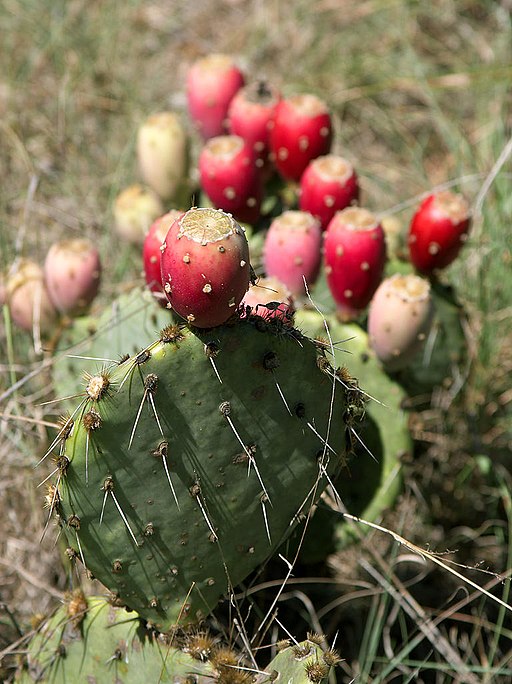
Prickly pear cacti are native to the Americas, but they’ve been spread all over the world by humans.
They’re grown for human food and as ornamental plants, and they also work well in desert terraria.
Prickly pear cacti are not only edible for bearded dragons, but some keepers offer their lizards prickly pear cactus pads specifically as food.
There are many species of prickly pear cacti, and they differ in terms of height, morphology, environmental requirements, and color.
Most are green, but others, such as the purple prickly pear (Opuntia macrocentra) are quite colorful.
As their name suggests, prickly pear cacti bear spines that may injure or irritate your lizard. However, you can often find cacti for sale that have had their spines removed. Note that you may need to prune your prickly pear cactus regularly to prevent it from outgrowing the habitat.
4. Aloe Plants (Aloe vera)
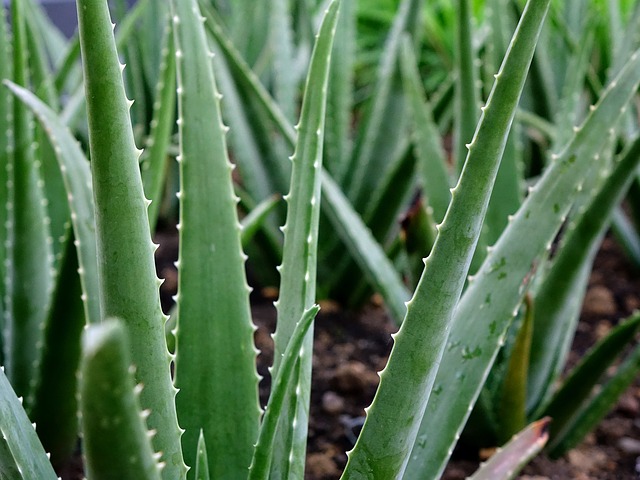
Long used by humans for their medicinal benefits, aloe plants often make great additions to bearded dragon habitats.
Aloe plants are historically native to arid regions surrounding the Indian Ocean, but – like prickly pear cacti – they’ve been introduced to a variety of other locations around the world.
- LIVE INDOOR PLANT: Bring home beautiful Aloe Vera to add a relaxing, calm feel to any space. Aloe...
- GREAT DECOR FOR ANY SPACE: Whether you're looking to spruce up your home office or add a touch of...
- ELEVATE MOOD & WELLBEING: Plants make us happy. They give us life, fresh air and a sense of calm -...
Note that the genus Aloe is quite large – it contains at least 500 described species. Some of these species grow quite large and reach tree-like proportions, so be sure to stick to smaller species and cultivars.
Most aloe plants bear green or greenish leaves, but some have very attractive mottled markings.
Some aloe plants bear very spikey leaves, but they rarely appear to cause problems for pet lizards.
5. Dwarf Jade Plants (Portulacaria afra)
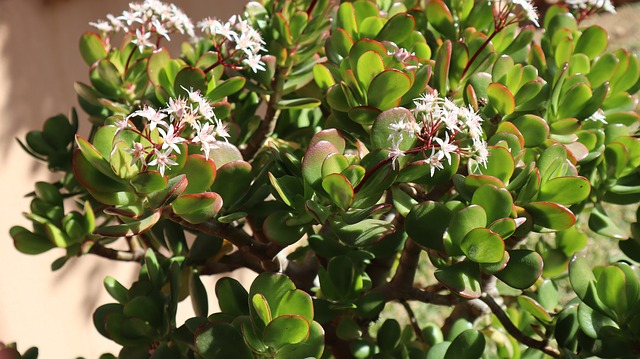
Native to the dry, rocky portions of eastern South Africa, dwarf jade plants typically grow as small trees in the wild.
However, with regular pruning, they can be kept relatively small – which is part of the reason they’re also popular among bonsai enthusiasts.
Dwarf jade plants are not thought to be toxic to bearded dragons, and humans even eat the leaves in salads.
However, it is important that you don’t confuse the dwarf jade plant (Portulacaria afra) we’re discussing here with the similar-looking (and more widely available) jade plant (Crassula ovata).
While the former is thought to be completely harmless, the latter is mildly toxic.
It is usually easy to get dwarf jade plant cuttings to take root, which makes it easy to turn a single jade plant into several smaller plants in short order.
6. Basil (Ocimum basilicum)
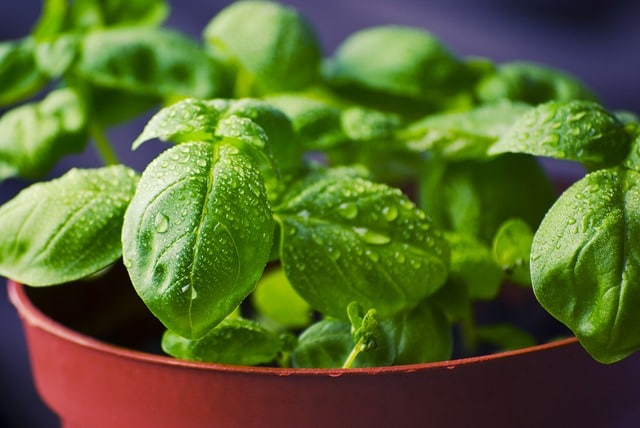
This popular kitchen herb is also a pretty good option for your bearded dragon’s enclosure.
Basil grows best outdoors, but with care and high-quality lighting, it is possible to get it to thrive indoors (such as in your dragon’s enclosure) too. Basil typically grows best when kept relatively warm, making it pretty well-suited for use in a terrarium.
Basil is native to the humid regions of Southeast Asia, which is obviously not very similar to your bearded dragon’s habitat.
However, the plant does not tolerate wet roots very well, so the quick drainage your bearded dragon’s substrate provides will usually allow you to give it enough water to survive.
Your bearded dragon may represent the biggest threat to the plant, as he may find the leaves tasty. Basil isn’t toxic to your lizard, but he may consume it more quickly than the plant can tolerate.
7. Parsley (Petroselinum crispum)
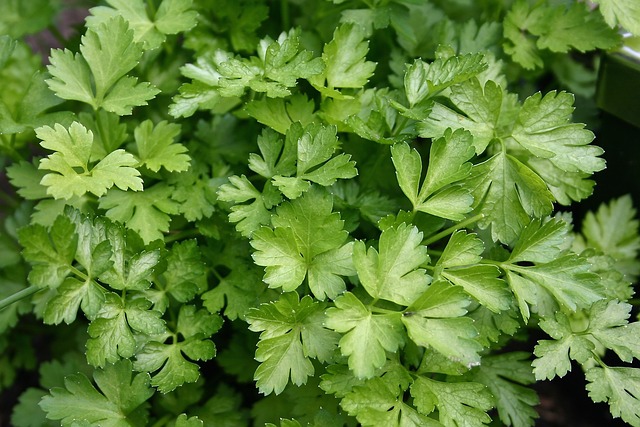
Another popular culinary plant, parsley is a great option for your bearded dragon’s enclosure.
Parsley will grow indoors if set up properly, although it grows best in real sunshine.
Nevertheless, it’ll often survive in warm, well-lit terraria for a while before it begins to get somewhat spindly.
The best reason to install parsley in your bearded dragon’s enclosure is that it is not only an edible plant but a fairly nutritious one too.
Some keepers regularly include parsley on their pet’s menu, so you can simply grow it in your habitat to ensure your pet always has tasty, edible vegetation available.
Parsley is native to the Mediterranean region, but it has been transplanted all over the world by humans.
8. Oregano (Origanum vulgare)
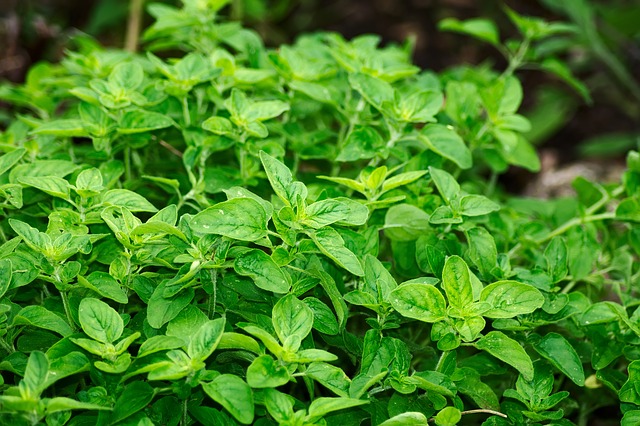
Oregano is another herb that you may want to consider planting in your dragon’s enclosure.
Oregano is safe and edible (although your bearded probably won’t be very interested in it), and it is free of thorns or any other potential dangers.
Oregano is native to western Asia and the Mediterranean region of Europe, where it thrives in the relatively warm and dry climate.
And, like many other herbs, oregano requires a soil or substrate that provides excellent drainage. Both of these traits make oregano well-suited for the environment in your bearded dragon’s habitat.
Oregano is an attractive little plant that may reach 3 feet in height when grown outdoors, but most indoor-grown specimens will remain much smaller.
9. Mulberry (Morus spp.)
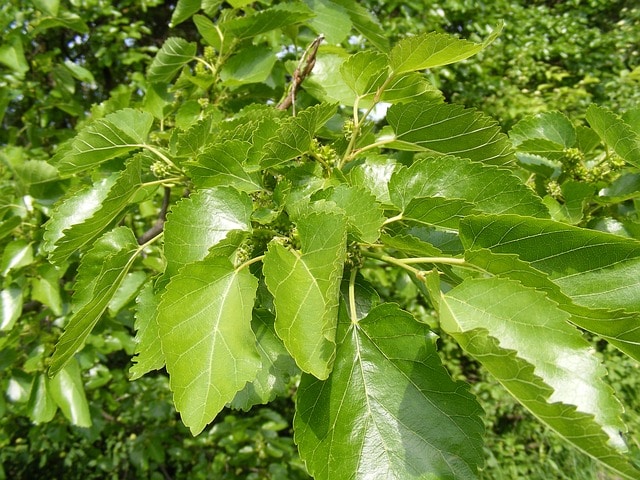
In contrast to the succulents and herbs we’ve previously discussed, mulberry is a woody plant that often grows into a proper tree.
This means you’ll need to prune it regularly to keep it small enough to fit in your pet’s habitat, and even then, it will be best suited for keepers who provide their dragon with a relatively tall enclosure.
Mulberry requires more water and moisture than the other plants we’ve discussed, so it is probably wise to leave mulberry plants in a separate pot instead of planting them directly in the substrate of your lizard’s habitat.
This will also make it easy to move the plant outdoors regularly, to help ensure it receives enough sunlight.
Mulberry fruits are edible, but you probably won’t see your plant fruit inside a terrarium. Nevertheless, the leaves are also safe for your lizard to eat, and many reptiles appear to find them quite tasty.
Potentially Poisonous Plants for Bearded Dragons
The following plants are known to be poisonous to some animals, and they may represent a threat to your bearded dragon too.
It’s possible (if not likely) that some of these are safe for bearded dragons to eat, but given the lack of concrete data available, it is better to err on the side of caution.
Note that poisonous plants vary in several ways. Many are toxic for some animals, yet harmless for others.
Additionally, some may cause death in animals that eat them, while others only cause minor symptoms, such as intestinal disturbances.
Further, many toxic species have a combination of edible and
dangerous tissues. For example, the fruits of many plants are perfectly safe to
eat, while their leaves or stalks may contain harmful compounds.
- Acokanthera – Acokanthera spp.
- Amaryllis – Amaryllis spp.
- Angel’s Trumpet – Datura spp.,
- Apple – Malus spp.
- Avocado – Persea americana
- Azalea – Rhododendron canadenis
- Baneberry – Actaea spp.
- Belladonna – Atropa belladonna
- Bird of Paradise – Poinciana spp.
- Bitter Melon – Momordica charantia
- Bittersweet – Celastrus spp.
- Black Locust – Robinia pseudoacacia
- Boxwood – Boxus spp.
- Braken Fern – Pteridium aquilinum
- Buckthorn – Karwinskia spp.
- Burdock – Arctium spp.
- Buttercup – Ranunculus spp.
- Caladium – Caladium spp.
- Calla Lily – Zantedeschia aethiopica
- Catclaw Acacia – Acacia greggii
- Castor Bean – Ricinus communis
- Cherry – Prunus spp.
- Chinaberry – Melia azadarach
- Clematis – Clematis spp.
- Coral Plant – Jatropha mutifida
- Crocus – Cholochicum autumnale
- Cycad– Cycas revoluta
- Daffodil – Narcissus tazetta
- Daphne – Daphne mezerum
- Death Camas – Zigadenus spp.
- Delphinium – Delphinium spp.
- Devil’s Ivy – Epipremnum aureum
- Dieffenbachia – Dieffenbachia spp.
- Eggplant – Solonum melongena
- Elderberry – Sambucus mexicana
- English Ivy – Hedera spp.
- Euonymus – Euonymus spp.
- Pennyroyal – Mentha pulegium
- Four o’clock – Mirabilis jalapa
- Heliotrope – Heliotropium spp.
- Henbane – Hyoscyamus niger
- Holly – Ilex spp.
- Horse Chestnut – Aesculus spp.
- Horse Nettle – Solanum carolinense
- Hyacinth – Hyacinthus orientalis
- Hydrangea – Hydrangea spp.
- Iris – Iris spp.
- Jack-in-the-Pulpit – Arisaema spp.
- Jerusalem Cherry – Solanum spp.
- Jonquil – Narcissus jonquilla
- Juniper – Juniperus spp.
- Lantana – Lantana camara
- Larkspur – Delphinium spp.
- Laurel – Kalmia spp.
- Lily-of-the-Valley – Convalleria majalis
- Lobelia – Lobelia spp.
- Locoweed – Astragalus spp. and
- Lupine – Lupinus spp.
- Marijuana – Cannabis spp.
- Milkweed – Asclepias spp.
- Mistletoe – Phoradendron villosum
- Mock Orange – Philadelphus spp.
- Moonseed – Menispermum canadense
- Monkshood – Aconitum spp.
- Morning Glory – Ipomoea violacea
- Narcissus – Narcissus spp.
- Oleander – Nerium oleander
- Oxytopis — Oxytopis spp.
- Peach – Prunus persica
- Peony – Paeonia officinalis
- Periwinkle – Vinca spp.
- Peyote – Lophophora williamsii
- Philodendron – Philodendron spp.
- Plum – Prunus spp.
- Poison Hemlock – Conium maculatum
- Poison Ivy/Oak/Sumac – Toxicodendron spp.
- Poinsettia – Euphorbia pulcherrima
- Poppy – Papaver spp.
- Pokeweed – Phytolacca americana
- Potato – Solanum tuberosum
- Pothos – Eprimemnum aureum
- Primrose – Prmula spp.
- Privet – Ligustrum vulgare
- Ragwort – Senecio spp.
- Rhododendron – Rhododendron spp.
- Rhubarb – Rheum rhabarbarum
- Rosary Pea – Abrus precatorius
- Sage – Salvia officinalis
- Shamrock Plant – Medicago lupulina
- Skunk Cabbage – Symplocarpus foetidus
- Snowdrop – Galanthus nivalis
- Sorrel – Rumex spp.
- Spurges – Euphorbia spp.
- Star of Bethlehem – Ornithogalum umbellatum
- Sweet Pea – Lathyrus odoratus
- Taro – Colocasia spp.
- Tobacco Plant – Nicotiania spp.
- Tomato Plant – Lycopersicon esculentum
- Tulip – Tulipa spp.
- Virginia Creeper – Panthenocissus quinquefolia
- Vetches – Vicia spp.
- Water Hemlock – Cicuta spp.
- Waxberry – Symphoricarpos albus
- Wisteria – Wisteria spp.
- Wood Sorrel — Oxalis spp.
- Yew – Taxus spp.
It bears mentioning that some studies have suggested that some lizard species are able to detect potential toxins in plant tissues and avoid eating them.
None have specifically focused on bearded dragons, but I’ve personally kept pothos plants with bearded dragons dozens of times and never had a problem, nor seen a bearded dragon even taste one of the leaves.
Also, researchers have documented lizards eating plants known to contain toxins without suffering ill effects
Ultimately, you must simply accept the fact that much remains to be learned about the relationship between toxic plants and reptiles.
So, you’ll simply need to err on the side of caution and make the best possible decisions you can on behalf of your pet.
Installing Plants in Your Bearded Dragon’s Tank
Now that you’ve selected the plants you want to keep in your dragon’s habitat, you will need to decide how you want to install them.
There are two basic options for arid habitats, which we’ll discuss below.
Install the Plants Directly in the Habitat’s Substrate
Inserting plants right in the substrate of your pet’s habitat is typically the most aesthetically pleasing, yet challenging approach.
To pull off this approach, you’ll need to use a substrate that is suitable for your lizard and the plants. Additionally, it will make habitat maintenance much more difficult.
However, for those willing to experiment and lose a few plants in the process, the results can be quite visually stunning.
Leave the Plants in Pots
The easiest way to add plants to your enclosure is to do so in the same way you’d add plants to your own home – just stick them in the habitat inside typical plant pots.
This doesn’t always look fantastic, but you can obscure and hide pots with corkbark, rocks and other decorative items.
In addition to making habitat maintenance easier, leaving plants inside separate pots also allows you to rotate them more easily.
In other words, you can maintain several potted plants and periodically place them in your pet’s habitat.
When they start showing signs of needing more light, you can just move them outside for a few weeks until they perk up a bit.
It is usually wise to re-pot plants before adding them to your terrarium and use pots that will provide enough space for the plant’s roots and still fit well in the habitat.
Can You Use Artificial Plants in Your Bearded Dragon’s Habitat?
Given some of the challenges involved in using live plants for your bearded dragon’s habitat, many keepers consider opting for artificial plants instead.
Plastic plants provide obvious benefits over live plants in several ways:
- They don’t require water or special lighting
- You don’t have to worry about them dying
- Your bearded dragon can knock them over every day without harming them
- You can move them around as often as you like
- You can simply wash them off if they become soiled
But the bigger question is: Are plastic plants safe to use with bearded dragons?
As with live plants, I’ll make no guarantees about the safety of using artificial plants in a bearded dragon’s enclosure.
But many keepers – including yours truly — have done so successfully. Once again, your decision will depend on your comfort with risk.
Plastic plants are safer than live plants in some ways, but they represent a greater threat to your lizard in other ways.
On one hand, while plastic is certainly not things that we should encourage our dragons to eat, they’re typically not considered “toxic” substances.
In fact, part of the reason plastic is used in so many varied applications is that it isn’t terribly reactive.
That said, the plastics used to produce cheap terrarium plants may be contaminated with just about anything, including toxic chemicals.
So, if you purchased high-quality, US-made plastic terrarium plants, you probably wouldn’t have to worry about them poisoning your lizard.
However, the larger risk is that the plastic foliage may cause a blockage in your pet’s digestive tract.
The plastic is unlikely to break down very much while inside your pet’s body and given the tight twists and turns of the intestinal tract, large pieces are very likely to become stuck.
In such circumstances, you’re likely to discover your dragon lying dead in the habitat one morning, or – in a “best case” scenario – you’ll note the problem in enough time to head to the vet.
Once there, you’ll spend an incredible sum to have the plastic surgically removed, with no guarantee that your pet will recover.
None of this means that your lizard will eat plastic plants – I don’t believe I’ve ever seen a bearded dragon seriously try to consume artificial plants.
After all, even the most realistic-looking artificial plants certainly don’t smell or taste real. But, if your lizard does try to eat them, you’re going to experience some problems.
So, if you do decide to incorporate artificial plants in your pet’s habitat, it is likely wise to keep your dragon extremely well-fed and to provide plenty of real vegetables on a very frequent basis.
Conclusion
Plants can be a great way to spruce up your dragon’s habitat and increase the complexity of the enclosure. But there are risks involved with doing so.
Ultimately, you’ll simply need to consider your appetite for risk and make the best possible decision you can on behalf of your pet.
Last update on 2025-04-18 / Affiliate links / Images from Amazon Product Advertising API

